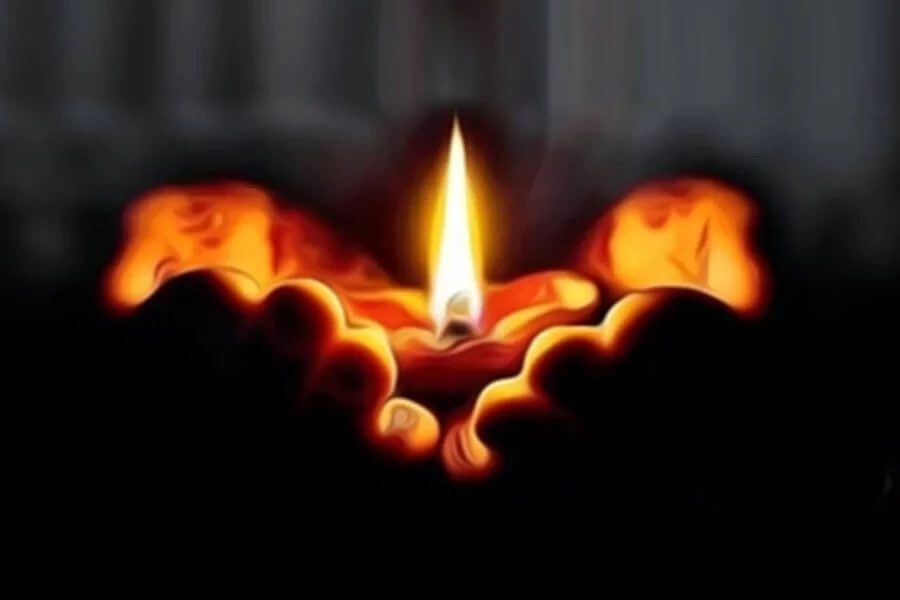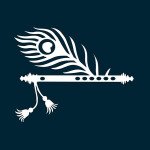Deepavali, meaning row of lights, is the annual festival of lights and fireworks in India, and now known the world over, wherever there are Indians. It is an old festival, its roots going far back in time.
The story that has come down through generations is that when Sri Rama returned to Ayodhya after completing fourteen years in exile, everyone in the city celebrated his return by lighting lamps. Light has always been an auspicious symbol in Sanatan Dharma and indeed in almost all religions.
But there is a deeper story here, a more evocative symbolism.
Sri Rama is the avatar, incarnation, of the Divine. And as all avatars, he resides as the inmost Light in all of us, deep in our hearts. This is the true meaning of avataran—the descent of the Divine into the human. Long before the outer form of the Avatar is visible to our eyes, he has already descended into the secret caves of our hearts and is preparing the grounds for his avataric work, a work that involves each one of us, whether we know it or not. But awareness of the Avatar within is always difficult for our sense-driven minds, habitually turned outward.
The lure of the sense objects and the charms of the outer world are strong, and the pull of the ego is irresistible. We cannot acknowledge the Lord in our hearts, we cannot revere the godhead in our souls, and so, unwittingly, sadly, we exile the Divine from our beings into the outer forests of our lives. So Sri Rama’s exile is, in a much deeper sense, our own exile. It is we who go wandering into the forests, those thick and dark forests of our desires and fears.
And it is in those formidable forests that we lose Sita to Ravana. Sita, who always returns, age after age, lifetime after lifetime, into our hearts and souls, as the pure crystalline love for the Divine—Sri Rama in one epoch, Sri Krishna in another. How does it matter if the names and forms change? The inner, that which is the true and infallible base of all our existence here on earth, remains the same, ever, through the roll of time and ages.
Sita is the Divine love seated secret in our inmost being. Each time our hearts rise up to the Godhead, in this form or that, it is Sita, and it is Radha,212 who rises in us as a pure flame of love and aspiration, quietly and blissfully, penetrating through all the outer layers and coverings of our unregenerate and stubborn earthly nature, drunk with the pride and arrogance of the ego.
Ravana is not out there, that ten-headed monstrosity that we burn each Dusshera. Ravana is that ego, the ten- headed asura, hidden deep in the folds of our own being, one head in the buddhi, another in the chitta, one in the heart, another in the prana, each head symbolizing a power of our own consciousness; Ravana plunges into our beings, in joyful abandon, and takes Sita captive, and this inner drama is repeated every time we surrender to the ego in us and exile the Divine. Ravana, mind you, does not look hideous at all. He looks charming, like a prince, which he indeed is, a veritable prince of darkness. His words enchant, and his voice mesmerizes. His eyes penetrate deep as if looking into your inmost secrets. Before you know it, you have lost your balance and have gone on a wild chase following a scent and a sight that you will never trace to the source. Such are the mysteries of the dark forests. And, in a trice, Sita is abducted. And all you hear is a soft whisper of prayer.
Rama’s struggle, then, is against the forces of our own nature. Make no mistake, he doesn’t fight the asura. He fights us, within ourselves. Each time. Repeatedly. The epic battle rages within us, in our hearts and souls, in our minds, in our bodies. Each part of our being is one front for the battle. On each front, we are fronted by one of the asura’s heads. And we get taken in only because all those heads look so much like our own in that dim light of our hearts.
But the Divine cannot be defeated. The victory is assured, now or in another hundred years—what does it matter in cosmic time? When Sri Rama wills the victory, a victory it shall be, no matter how many Ravanas stand ranged against him. When Sri Krishna wills a victory, victory again it shall be, no matter how many Naraksuras rise against him. For the asuras rise and fall by the will of the Divine, and behind all those numerous risings of the asuras is a deeper mystery and purpose, something still to be unearthed from the pits of the forests that engulf us in our own exiles.
But the battle will be won. Eventually. Inevitably. The forests will burn, and the blaze will illumine the dark. Sri Rama will return from exile. Sri Krishna will return to his rightful throne in his rightful kingdom. The exile will end. For each exile returns the godhead to itself. And so, Sri Rama returns to Ayodhya, that real Ayodhya deep in our beings, that sacred invincible space that lives in each of us—ayodhya, which cannot be attacked or vanquished.
And when Sri Rama walks down the gold-paved path of this Ayodhya, deeper into our hearts, we light a lamp to express our gratitude, our prayer, and our love. And we seek to become that lamp, that deepa, that we must kindle with our own sacred Agni, that same Agni lit by our ancestors, our forefathers, our maharshis, age after age, that same Agni brought down by the ancient gods from those high regions that have now receded in time and consciousness.
And this lighting of the lamp must be understood for what it is—an act of profound reverence, an act that symbolically connects us in spirit to the primordial Agni, that first explosion of Light from the womb of the Unknown. It is thus that we can become the act and the symbol, embody consciously that illumination that cannot be extinguished. And, secure in that knowing, we bow in love and gratitude as Sri Rama returns with Sita beside him, for Sita, too, is eternal.
Do not misunderstand that ancient event, that beautiful metaphor, of Sita descending into the earth and disappearing. Sita does not disappear nor does she despair. Sita’s love for Sri Rama is not subject to time or circumstances, politics or culture. Sita’s love is sanatan—eternal and universal. She loves him not just for herself but for each one of us, for all embodied life that must live through a thousand agni-parikshas, a thousand trials by fire, where many shall burn to ash, and many shall be redeemed by fire. The fire that consumes is also the fire that purifies and restores.
When we burn in the living flames of our inner hells, it is that love of hers for Sri Rama that can keep us from burning to ash. And when the fire purifies and redeems, transforming a part of us into pure flame, it is that love of hers for Sri Rama that keeps us from melting into the transmuting furnace.
So, Sita’s descent into earth is her secret descent into the terrestrial body—our bodies—for this body of earth is one. She does not disappear, for she who is born of fire and earth returns to fire and earth, resplendent with her love for Sri Rama.
And so, deepavali—the spiritual, the inner deepavali—the row of lamps signifying those inner states of being that must be brought to the light of consciousness in each of us—benevolence, humility, gratitude, purity, peace, and joy. These inner states are auspicious and divine, and to invoke these is to invoke Sri, the Divine’s sweet grace and splendor. Sri, this grace and splendor of the Divine, is not outside of us; it arises from within, of itself, when we light those symbol lamps in our consciousness. One by one. Carefully, with sincerity that burns all the dross, with love that consumes the ego. One by one. Mindfully. Prayerfully.
Then deepavali happens. The real deepavali. The night lights up and dances with joy, the joy of divinity, the joy of utter self- giving. In that dance of joy, the Mother descends as Lakshmi, the godhead of prosperity and wealth. Wealth is always spiritual first, and so is prosperity. Material wealth and prosperity are but inevitable expressions of spiritual wealth, the spiritual grace. We have forgotten this over the ages. We have turned outward, and we invoke the Grace in external forms through external rituals.
The true deepavali is a reversal: a turning inward, lighting the lamps of consciousness with the inner Agni of our aspiration for the Divine—Thou, thou alone, Mother. The true invocation is not for wealth, not for health, not for mangalam, but for the Mother Herself, for Sri to descend into our lives. Then, no other mantra or worship is needed. Our call, ever so softly whispered in our own hearts, becomes the mantra; our love for Her, however delicate, however frail, becomes the worship, the puja. Then deepavali happens—in us, and in the world outside. The true Deepavali, then is our conscious offering to the Light, to that Light which is the foremost symbol of the Divine Truth, to that Light which returns us eternally to the very source of all life in the universe—and to that undying Light of godhead in us, may our prayers and offerings go forth.
Excerpted from Partho's latest book This is Sanatan Dharma, the Quest for Truth published by BluOne Ink










